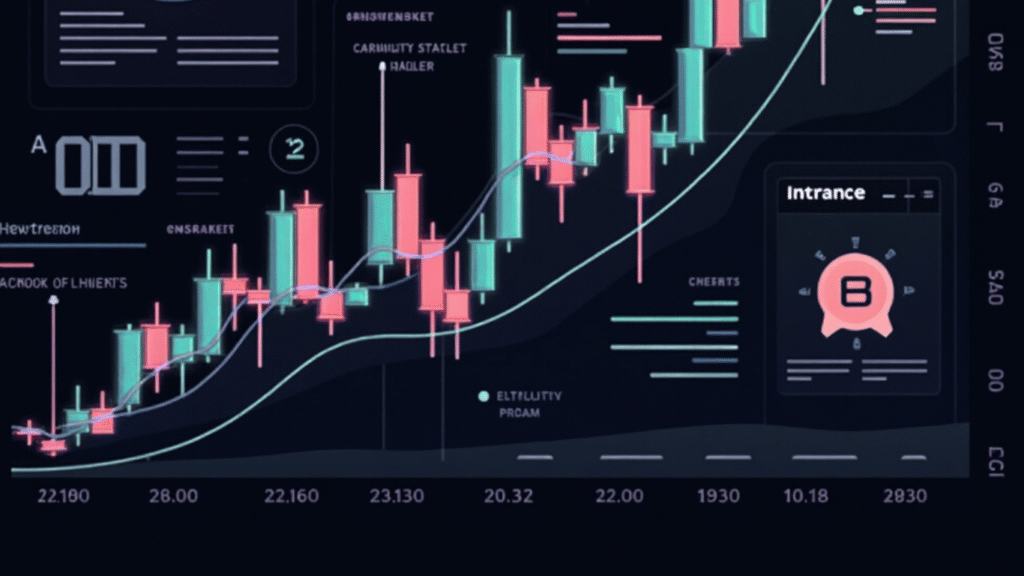Why Is the Crypto Market Crashing? [May 17 Update]

Why Is the Crypto Market Crashing?
If you’ve been checking your portfolio this weekend and wondering why everything is red, you’re not alone. The crypto market took a hit again on Saturday, May 17, and a lot of us are feeling it. Bitcoin slipped from this week’s high, and altcoins — well, they got slammed even harder. It’s not the first time we’ve seen this, and it definitely won’t be the last.
Let’s break down what’s going on, why the market is pulling back, and what this might mean moving forward. I’ll keep it real, straightforward, and hopefully help you make some sense of the chaos.
1.Bitcoin Lost Steam at $105K
Bitcoin is like the king of the crypto jungle — when it moves, the rest of the market usually follows. Earlier this week, Bitcoin hit a local high of around $105,000, which had a lot of people buzzing. Many were hopeful that BTC might smash through its previous all-time highs and kick off another massive bull run.
But here’s where things got tricky. Instead of breaking through and heading even higher, Bitcoin hit a strong resistance level at $105,000 and just couldn’t push past it. Soon after, its price slipped back down to about $103,000. That might seem like a small dip if you’re used to the wild price swings in crypto, but this small retreat triggered a pretty big reaction across the board.
Why? Because Bitcoin essentially acts as the market’s bellwether — a leading indicator of market sentiment. When Bitcoin struggles or pulls back, especially after an exciting rally, investors get cautious. Many start to lock in profits, and some begin selling altcoins to cut their losses or preserve gains.
The result? Altcoins often fall much harder in percentage terms than Bitcoin itself. This is because they’re generally riskier and less established. So when Bitcoin stumbles, the panic trickles down and amplifies the declines in smaller tokens.
To put it simply: Bitcoin’s stumble at that $105,000 mark was like the first domino falling. It set off a chain reaction where traders started selling, taking profits, and pulling back from riskier bets. That’s why the whole market looked red on Saturday, May 17.
2.Altcoins Got Hit Harder and Here’s Why
When Bitcoin dropped just a couple of grand, the altcoin market plummeted. Some of the biggest losers on Saturday include:
- Pi Network (PI) – down 21.48%
- Bonk (BONK) – down 11.41%
- Floki (FLOKI) – down 9.13%
- Pudgy Penguins (PENGU) – down 9.32%
Why such a steep fall? Because many of these tokens had just rallied massively. For example, Bonk was up nearly 200%, Floki gained over 160%, and PENGU surged more than 330% from their April lows.
What we’re seeing now is classic profit-taking. People who bought the dip a month ago are now locking in profits. It’s natural and healthy for markets to correct after such a big run. But it’s never fun when it happens all at once.
3. Market Risks: Macro Uncertainty Looms Large
Crypto might feel like its own world, but macroeconomic risks still have a huge influence.
Here’s what’s happening in the background:
- The U.S. and China reached a shaky trade truce, but 30% tariffs remain.
- A 10% tariff is still in place on most goods from the UK.
- Trade talks with Japan have stalled.
These lingering tensions are shaking global investor confidence. Add to that rising interest rates and fears of an economic slowdown, and you’ve got a risk-off environment — not ideal for speculative assets like crypto.
In fact, prediction platform Polymarket recently bumped the odds of a U.S. recession to 38%. When recession fears go up, risky assets like crypto are usually the first to take a hit.
4. Moody’s Downgrades the U.S. Outlook

To top it all off, Moody’s one of the top credit rating agencies downgraded the U.S. economic outlook on Friday. Their reasoning? A combination of:
- Sky-high public debt
- Political gridlock
- Long-term fiscal instability
This downgrade might sound like something only Wall Street should care about, but in reality, it impacts everything — including crypto. It shakes global market confidence and sends investors scrambling for safe havens. And when that happens, Bitcoin and altcoins are usually not on the shopping list.
5. Technical Factors & Whale Activity
Beyond the news and headlines, there’s also market mechanics at play.
- Bitcoin hitting resistance triggered stop-losses and automated sell-offs.
- Some traders were over-leveraged, leading to liquidations.
- Whales may have started dumping after booking profits, flooding the market with large orders.
When the price starts falling quickly, panic spreads. Retail traders sell to cut losses. Bots accelerate the drop. And before you know it, you’ve got a full-blown correction.
When the crypto market crashes or rallies, it’s rarely just about headlines or big news. A lot of the movement comes down to what’s happening under the hood — the technical side of trading, and the behavior of the biggest players in the market, often called “whales.”
What Are Technical Factors?
Technical factors refer to patterns, price levels, and trading behaviors visible on the charts that traders use to make decisions. In crypto, because the market runs 24/7 and is highly liquid, technical analysis plays a huge role in how prices move.
One of the biggest technical concepts that affected the recent crash was resistance levels. A resistance level is a price point where selling pressure tends to outweigh buying, causing the price to stall or reverse. Bitcoin’s recent inability to break through the $105,000 resistance was a classic example.
When BTC couldn’t push higher, many traders started seeing this as a signal to take profits or reduce exposure. This collective action triggered a wave of sell orders, which then caused the price to drop. Once the price dips below certain levels, it triggers even more sell orders due to stop-losses — pre-set automatic sell points that traders use to limit losses.
The combination of failed resistance and triggered stop-losses can lead to sharp price declines within minutes or hours — exactly what happened on May 17.
Liquidations Amplify the Downward Spiral
In crypto, a lot of trading is done on margin — meaning traders borrow money to increase their position size, hoping to magnify gains. While this can boost profits, it also increases risk.
When prices fall rapidly, margin traders can face liquidation — forced closing of their positions by exchanges to prevent losses exceeding their collateral. Liquidations cause exchanges to sell off assets automatically, adding more selling pressure to the market.
During the recent pullback, a cascade of liquidations in leveraged positions amplified the price drop, turning a small correction into a sharper crash. This is one reason why crypto price moves can sometimes be faster and more volatile than traditional assets.
The Role of Whales
Now, let’s talk about whales — a nickname for individuals or entities holding massive amounts of crypto, often worth millions or billions of dollars. Whales can move markets simply by buying or selling large quantities.
During bullish runs, whales often accumulate coins gradually, helping sustain price momentum. But when they decide to take profits or exit positions, their large sales can flood the market, causing prices to drop sharply.
Reports and on-chain data indicated that some whales started selling off significant Bitcoin and altcoin holdings after the recent rally. This likely contributed to the increased sell pressure and accelerated the market’s downward movement.
Whales also tend to be well-informed and have access to advanced trading strategies and tools. When they act, smaller retail traders often follow suit, creating a domino effect.
Market Sentiment and Fear
Technical triggers and whale activity feed into broader market psychology. When traders see sudden drops, especially fueled by liquidations and whale sales, fear often kicks in. This leads to more selling, which drives prices even lower.
Crypto markets are highly sentiment-driven — news, social media, and community chatter can amplify emotions. So once a technical trigger sets off liquidations and whales begin selling, the resulting fear and uncertainty can snowball into larger sell-offs.
Conclusion:

crypto crashes can be gut-wrenching. One day everything’s pumping, your portfolio’s glowing green, and Twitter is full of laser-eye profile pics. Then suddenly, Bitcoin stumbles, altcoins tumble, and fear starts to spread like wildfire.
But here’s the thing: this isn’t the first time, and it won’t be the last.
The recent crypto crash is a classic case of a market correction — driven by a mix of technical resistance, profit-taking, macro uncertainty, and whale activity. Add to that some anxiety from inflation numbers, Moody’s U.S. credit downgrade, and stalled global trade talks, and it’s no surprise we’re seeing volatility.
Bitcoin couldn’t break above $105,000, which set off a chain reaction. Altcoins, which had just surged thanks to Bitcoin’s rise, dropped even harder. Many of the biggest gainers — like BONK, FLOKI, and PENGU — suddenly turned into the biggest laggards as short-term traders locked in profits.
Behind the scenes, the drop was fueled by technical sell-offs, margin liquidations, and large whale movements, all of which compounded the selling pressure. It’s a reminder that in crypto, the speed of price swings is often intensified by the tools and players operating in the market.
But zoom out for a second.
Even with this pullback, many cryptocurrencies are still way up compared to earlier this year. And the long-term picture for crypto adoption, innovation, and institutional involvement remains strong. Corrections like these are part of the natural rhythm of any maturing market.
So, what should you do?
- Don’t panic sell just because prices are down — zoom out and assess the fundamentals.
- Use these moments to re-evaluate your strategy, manage your risk, and stay informed.
- Remember: volatility is part of the game in crypto. The key is learning how to navigate it, not just ride the highs.
Markets breathe. They go up, they correct, and sometimes they tumble — but it’s the long-term vision, not the short-term noise, that determines success.
So take a breath, stay curious, and keep learning. The market might be red today, but history shows that crypto has bounced back time and again. And who knows? The next rally might just be around the corner. see


